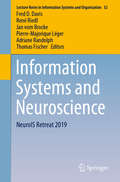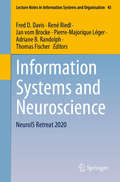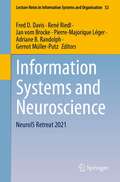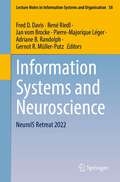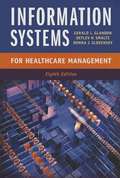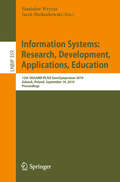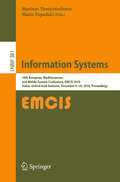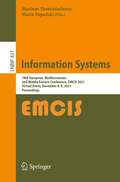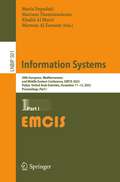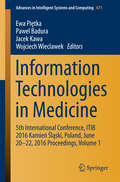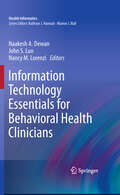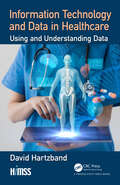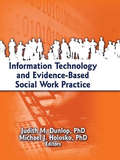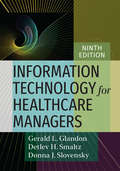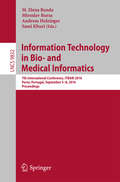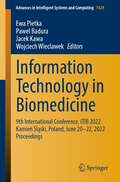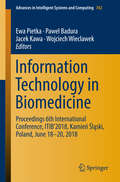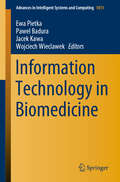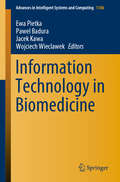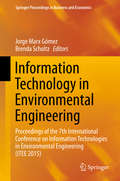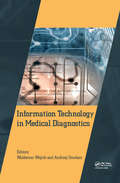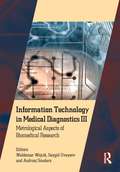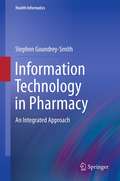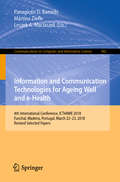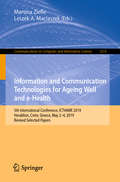- Table View
- List View
Information Systems and Neuroscience: NeuroIS Retreat 2019 (Lecture Notes in Information Systems and Organisation #32)
by Thomas Fischer Jan Vom Brocke René Riedl Pierre-Majorique Léger Fred D. Davis Adriane RandolphThis book presents the proceedings of the NeuroIS Retreat 2019, held on June 4–6 in Vienna, Austria, reporting on topics at the intersection of information systems (IS) research, neurophysiology and the brain sciences. Featuring the latest findings from top scholars in the field, it offers detailed insights into the neurobiology underlying IS behavior, essential methods and tools and their applications for IS, as well as applying neuroscience and neurophysiological to advance IS theory.
Information Systems and Neuroscience: NeuroIS Retreat 2020 (Lecture Notes in Information Systems and Organisation #43)
by Thomas Fischer Jan Vom Brocke René Riedl Pierre-Majorique Léger Fred D. Davis Adriane B. RandolphThis book presents the proceedings of the virtual conference NeuroIS Retreat 2020, June 2–4, hosted in Austria, reporting on topics at the intersection of information systems (IS) research, neurophysiology and the brain sciences. Readers will discover the latest findings from top scholars in the field of NeuroIS, which offer detailed insights on the neurobiology underlying IS behavior, essential methods and tools and their applications for IS, as well as the application of neuroscience and neurophysiological theories to advance IS theory.
Information Systems and Neuroscience: NeuroIS Retreat 2021 (Lecture Notes in Information Systems and Organisation #52)
by Jan Vom Brocke René Riedl Pierre-Majorique Léger Fred D. Davis Adriane B. Randolph Gernot Müller-PutzThis book presents the proceedings of the NeuroIS Retreat 2021, June 1-3, virtual conference, reporting on topics at the intersection of information systems (IS) research, neurophysiology and the brain sciences. Readers will discover the latest findings from top scholars in the field of NeuroIS, which offer detailed insights on the neurobiology underlying IS behavior, essential methods and tools and their applications for IS, as well as the application of neuroscience and neurophysiological theories to advance IS theory.
Information Systems and Neuroscience: NeuroIS Retreat 2022 (Lecture Notes in Information Systems and Organisation #58)
by Jan Vom Brocke René Riedl Pierre-Majorique Léger Fred D. Davis Adriane B. Randolph Gernot R. Müller-PutzThis book presents the proceedings of the NeuroIS Retreat 2022, June 14-16, Vienna, Austria, reporting on topics at the intersection of information systems (IS) research, neurophysiology and the brain sciences. Readers will discover the latest findings from top scholars in the field of NeuroIS, which offer detailed insights on the neurobiology underlying IS behavior, essential methods and tools and their applications for IS, as well as the application of neuroscience and neurophysiological theories to advance IS theory.
Information Systems for Healthcare Management (Eighth Edition)
by Donna J. Slovensky Gerald L. Glandon Detlev H. SmaltzThis bestseller provides readers with the comprehensive knowledge necessary to understand healthcare information technology (HIT) and to hone their skills in HIT management. The book explores the areas where leaders must exhibit basic awareness or competency, including hardware, software, and communication systems; operational, management, and clinical applications; and selection, implementation, and valuation. <p><p> Each chapter has been updated to reflect current trends and challenges in the field as well as the implications of the 2010 healthcare reform law and other relevant federal mandates. Each chapter also features learning objectives, web resources, and discussion questions. This revised edition includes a glossary that clarifies technical terms as well as a list of abbreviations for important terms. Links to Internet sources are provided to supplement the information on the major topics covered in each chapter.
Information Systems: 12th SIGSAND/PLAIS EuroSymposium 2019, Gdansk, Poland, September 19, 2019, Proceedings (Lecture Notes in Business Information Processing #359)
by Stanisław Wrycza Jacek MaślankowskiThis book constitutes the refereed proceedings of the 12th SIGSAND/PLAIS EuroSymposium 2019 held in Gdansk, Poland, on September 19, 2019. The objective of the EuroSymposium on Systems Analysis and Design is to promote and develop high quality research on all issues related to information systems (IS) and in particular in systems analysis and design (SAND). The 12 papers presented in this volume were carefully reviewed and selected from 32 submissions. They were organized in topical sections named: information systems in business; health informatics and life-long-learning; IT security; agile methods and software engineering.
Information Systems: 16th European, Mediterranean, and Middle Eastern Conference, EMCIS 2019, Dubai, United Arab Emirates, December 9–10, 2019, Proceedings (Lecture Notes in Business Information Processing #381)
by Marinos Themistocleous Maria PapadakiThis book constitutes selected papers from the 16th European, Mediterranean, and Middle Eastern Conference, EMCIS 2019, held in Dubai, UAE, in October 2019. EMCIS is dedicated to the definition and establishment of Information Systems as a discipline of high impact for the methodical community and IS professionals, focusing on approaches that facilitate the identification of innovative research of significant relevance to the IS discipline.The 48 full papers presented in this volume were carefully reviewed and selected from a total of 138 submissions. They were organized in topical sections named: Big Data and Analytics; Blockchain Technology and Applications; Cloud Computing; Digital Services and Social Media; e-Government; Enterprise Information Systems; Health-Care Information Systems; Information Systems Security and Information Privacy Protection; Innovative Research Projects; IT Governance; and Management and Organizational Issues in Information Systems.
Information Systems: 18th European, Mediterranean, and Middle Eastern Conference, EMCIS 2021, Virtual Event, December 8–9, 2021, Proceedings (Lecture Notes in Business Information Processing #437)
by Marinos Themistocleous Maria PapadakiThis book constitutes selected papers from the 18th European, Mediterranean, and Middle Eastern Conference, EMCIS 2021, which took place during December 8-9, 2021. The conference was initially planned to take place in Dubai, UAE, but had to change to an online event due to the COVID-19 pandemic.EMCIS covers technical, organizational, business, and social issues in the application of information technology and is dedicated to the definition and establishment of Information Systems (IS) as a discipline of high impact for IS professionals and practitioners. It focuses on approaches that facilitate the identification of innovative research of significant relevance to the IS discipline following sound research methodologies that lead to results of measurable impact. The 54 full papers presented in this volume were carefully reviewed and selected from a total of 155 submissions. They were organized in topical sections named: Big Data and Analytics; Blockchain Technology and Applications; Cloud Computing; Digital Governance; Digital Services and Social Media; Emerging Computing Technologies and Trends for Business Process Management; Healthcare Information Systems; Information Systems security and Information Privacy Protection; Innovative Research Projects; IT Governance and Alignment; and Management and Organisational Issues in Information Systems.
Information Systems: 20th European, Mediterranean, and Middle Eastern Conference, EMCIS 2023, Dubai, United Arab Emirates, December 11-12, 2023, Proceedings, Part I (Lecture Notes in Business Information Processing #501)
by Marinos Themistocleous Khalid Al Marri Maria Papadaki Marwan Al ZarouniThis book constitutes selected papers from the 20th European, Mediterranean, and Middle Eastern Conference, EMCIS 2023, which was held in Dubai, UAE, during December 11-12, 2023. EMCIS covers technical, organizational, business, and social issues in the application of information technology and is dedicated to the definition and establishment of Information Systems (IS) as a discipline of high impact for IS professionals and practitioners. It focuses on approaches that facilitate the identification of innovative research of significant relevance to the IS discipline following sound research methodologies that lead to results of measurable impact. The 43 papers presented in this volume were carefully reviewed and selected from a total of 126 submissions. They were organized in topical sections as follows: Part I: Metaverse; blockchain technology and applications; digital governance; healthcare information systems; artificial intelligence; Part II: Big data and analytics; digital services and social media; innovative research projects; managing information systems; smart cities.
Information Technologies in Medicine
by Ewa Piętka Pawel Badura Jacek Kawa Wojciech WieclawekITiB'2016 is the 5th Conference on Information Technologies in Biomedicine organized by the Department of Informatics & Medical Equipment of Silesian University of Technology every other year. The Conference is under the auspices of the Committee on Biocybernetics and Biomedical Engineering of the Polish Academy of Sciences. The meeting has become a recognized event that helps to bridge the gap between methodological achievements in engineering and clinical requirements in medical diagnosis, therapy, and rehabilitation. Mathematical information analysis, computer applications together with medical equipment and instruments have become standard tools underpinning the current rapid progress with developing Computational Intelligence. Members of academic societies of technical and medical background present their research results and clinical implementations. ent. This proceedings (divided in 2 volumes) include the following sections: Ø Image Processing Ø Signal Processing Ø Medical Information System & Database Ø Ambient Assisted Living Ø Bioinformatics Ø Modeling & Simulation Ø Biomechatronics Ø Biomaterials
Information Technology Essentials for Behavioral Health Clinicians
by Nancy M. Lorenzi John Luo Naakesh DewanThe purpose of this book is to be the premier resource for behavioural health clinicians who are considering adopting technology into their practice. Written by experts and policy makers in the field this book will be recognized as the gold standard. Other books currently in this field are extremely technical and are geared primarily to policy makers, researchers and informaticians. While this book will be a useful adjunct to that audience, it is primarily designed for the over .5 million behavioural health clinicians in the U.S. and the millions others around the world. Adoption of technology is slow in behavioural healthcare, and this book will enhance the adoption and utilization of various technologies in practice. I.T. vendors may also purchase this book for their customers.
Information Technology and Data in Healthcare: Using and Understanding Data (HIMSS Book Series)
by David HartzbandHealthcare transformation requires us to continually look at new and better ways to manage insights – both within and outside the organization. Increasingly, the ability to glean and operationalize new insights efficiently as a byproduct of an organization’s day-to-day operations is becoming vital for hospitals and health systems to survive and prosper. One of the long-standing challenges in healthcare informatics has been the ability to deal with the sheer variety and volume of disparate healthcare data and the increasing need to derive veracity and value out of it. This book addresses several topics important to the understanding and use of data in healthcare. First, it provides a formal explanation based on epistemology (theory of knowledge) of what data actually is, what we can know about it, and how we can reason with it. The culture of data is also covered and where it fits into healthcare. Then, data quality is addressed, with a historical appreciation, as well as new concepts and insights derived from the author’s 35 years of experience in technology. The author provides a description of what healthcare data analysis is and how it is changing in the era of abundant data. Just as important is the topic of infrastructure and how it provides capability for data use. The book also describes how healthcare information infrastructure needs to change in order to meet current and future needs. The topics of artificial intelligence (AI) and machine learning in healthcare are also addressed. The author concludes with thoughts on the evolution of the role and use of data and information going into the future.
Information Technology and Evidence-Based Social Work Practice
by Michael J. Holosko Judith M. DunlopLearn to use the latest technological advances in evidence-based social workSocial work practice can be positively or negatively impacted by the advance of technology. Advances and applications must be up-to-date as possible, yet they may be ineffective if not simple enough to easily learn and use. Information Technology and Evidence-Based Social Work presents leading social work experts exploring the latest technological advances and the innovative practical applications which can be used effectively in evidence-based social work. Students and practitioners get creative practical advice on how best understand technology and apply it to their work.Information Technology and Evidence-Based Social Work is divided into four sections. The first section provides the context for understanding the technological link between social work and evidence-based practice. The second section presents examples of how information technology can be used to effectively teach students and practitioners in the field. Section three explores ways to implement technology for use by clients. The fourth section summarizes and then takes a look at the future of technology in evidence-based social work. Chapters include questions for practitioners and for clients to illuminate the current and future issues surrounding technology and evidence-based practice. The text also includes extensive references, and useful tables and figures.Topics in Information Technology and Evidence-Based Social Work include: the impact of technology on social work computer-assisted evidence-based practice customized web-based technology and its use in clinical supervision enhanced technology-based evidence-based practice model and its applicability to large human service organizations. using information technology to provide evidence for planning and evaluating programs using technology in advocacy the geographic information system (GIS) as a useful tool in all aspects of programs and policies evaluating practice through information technology the development and evaluation of an online social work service psychotherapeutic group intervention for family caregivers over the Internet support group online chat a case study of how Internet chat group technology can be implemented with cancer survivors technology as a service learning mechanism for promoting positive youth development in a community-based setting a model which can be used to collect information and—by using best evidence available—arrive at a confident decision and more! Information Technology and Evidence-Based Social Work is timely, stimulating reading for educators, undergraduate students, graduate students, and practitioners in the fields of social work, psychology, and public administration.
Information Technology for Healthcare Managers, Ninth edition
by Donna J. Slovensky Gerald L. Glandon Detlev H. SmaltzThough healthcare is largely technology driven, the deployment of health information technology (HIT) has occurred in waves rather than a steady flow, and usually in response to government mandates. This emergent HIT strategy has culminated in highly complex and dynamic systems crafted over many years using products from multiple vendors. Healthcare organizations are now focused on big data aggregated from myriad data-producing applications both in and beyond the enterprise. Healthcare leaders must position themselves to leverage the new opportunities that arise from HIT's ascendance and to mine the vast amount of available data for competitive advantage. Where can they turn for insight? With the unique advantage of both academic and real-world experience in HIT leadership, the authors of Information Technology for Healthcare Managers blend management theory, cutting-edge tech knowledge, and a thorough grounding in the healthcare applications of technology. Opinions abound on technology's best uses for society, but healthcare organizations need more than opinion—they need knowledge and strategy. This book will help leaders combine tech savvy with business savvy for sustainable success in a dynamic environment.
Information Technology in Bio- and Medical Informatics
by M. Elena Renda Miroslav Bursa Andreas Holzinger Sami KhuriThis book constitutes the refereed proceedings of the 6th International Conference on Information Technology in Bio- and Medical Informatics, ITBAM 2015, held in Valencia, Spain, in September 2015, in conjunction with DEXA 2015. The 9 revised long papers presented together with 1 poster paper were carefully reviewed and selected from 15 submissions. The papers address the following two topics: medical terminology and clinical processes and machine learning in biomedicine.
Information Technology in Biomedicine: 9th International Conference, ITIB 2022 Kamień Śląski, Poland, June 20–22, 2022 Proceedings (Advances in Intelligent Systems and Computing #1429)
by Pawel Badura Jacek Kawa Wojciech Wieclawek Ewa PietkaThis book presents a comprehensive study in the field of advances in medical data science and contains carefully selected articles contributed by experts of information technology. Continuous growth of the amount of medical information and the variety of multimodal content necessitates the demand for a fast and reliable technology able to process data and deliver results in a user-friendly manner at the time and place the information is needed. Computational approaches for understanding human complexity, AI-powered applications in image and signal processing, bioinformatics, sound and motion as activity stimulus, joint activities in biomedical engineering and physiotherapy, disorder in children, selected comparative studies give new meaning to optimization of the functional requirements of the healthcare system for the benefit of the patients. It is an interdisciplinary collection of papers that have both theoretical and applied dimensions. It includes the following research areas: Computational methods for understanding human complexity Image and signal analysis Multidimensional medical data analysis Sound and motion Joint activities in biomedical engineering and physiotherapy This book is a great reference tool for scientists who deal with problems of designing and implementing information processing tools employed in systems that assist the clinicians, radiologists, and physiotherapists in patient diagnosis and treatment. It also serves students in exploring innovations in quantitative medical data analysis, data mining, and artificial intelligence.
Information Technology in Biomedicine: Proceedings 6th International Conference, ITIB’2018, Kamień Śląski, Poland, June 18–20, 2018 (Advances in Intelligent Systems and Computing #762)
by Pawel Badura Jacek Kawa Wojciech Wieclawek Ewa PietkaITiB’2018 is the 6th Conference on Information Technology in Biomedicine, hosted every two years by the Department of Informatics & Medical Devices, Faculty of Biomedical Engineering, Silesian University of Technology. The Conference is organized under the auspices of the Committee on Biocybernetics and Biomedical Engineering of the Polish Academy of Sciences. The meeting has become an established event that helps to address the demand for fast and reliable technologies capable of processing data and delivering results in a user-friendly, timely and mobile manner. Many of these areas are recognized as research and development frontiers in employing new technology in the clinical setting. Technological assistance can be found in prevention, diagnosis, treatment, and rehabilitation alike. Homecare support for any type of disability may improve standard of living and make people’s lives safer and more comfortable. The book includes the following sections: Ø Image Processing Ø Multimodal Imaging and Computer-aided Surgery Ø Computer-aided Diagnosis Ø Signal Processing and Medical Devices Ø Bioinformatics Ø Modelling & Simulation Ø Analytics in Action on the SAS Platform Ø Assistive Technologies and Affective Computing (ATAC)
Information Technology in Biomedicine: Proceedings 6th International Conference, Itib'2018 Kamieski, Poland June 18-20 2018 (Advances in Intelligent Systems and Computing #1011)
by Pawel Badura Jacek Kawa Wojciech Wieclawek Ewa PietkaThis book provides a comprehensive overview of advances in the field of medical data science, presenting carefully selected articles by leading information technology experts. Information technology, as a rapidly evolving discipline in medical data science, with significant potential in future healthcare, and multimodal acquisition systems, mobile devices, sensors, and AI-powered applications has redefined the optimization of clinical processes. This book features an interdisciplinary collection of papers that have both theoretical and applied dimensions, and includes the following sections: Medical Data Science Quantitative Data Analysis in Medical Diagnosis Data Mining Tools and Methods in Medical Applications Image Analysis Analytics in Action on SAS Platform Biocybernetics in Physiotherapy Signal Processing and Analysis Medical Tools & Interfaces Biomechanics and Biomaterials. As such, it is a valuable reference tool for scientists designing and implementing information processing tools used in systems that assist clinicians in patient care. It is also useful for students interested in innovations in quantitative medical data analysis, data mining, and artificial intelligence.
Information Technology in Biomedicine: Proceedings 6th International Conference, Itib'2018 Kamieski, Poland June 18-20 2018 (Advances in Intelligent Systems and Computing #1186)
by Pawel Badura Jacek Kawa Wojciech Wieclawek Ewa PietkaThe rapid and continuous growth in the amount of available medical information and the variety of multimodal content has created demand for a fast and reliable technology capable of processing data and delivering results in a user-friendly manner, whenever and wherever the information is needed. Multimodal acquisition systems, AI-powered applications, and biocybernetic support for medical procedures, physiotherapy and prevention have opened up exciting new avenues in terms of optimizing the healthcare system for the benefit of patients. This book presents a comprehensive study on the latest advances in medical data science and gathers carefully selected articles written by respected experts on information technology. Pursuing an interdisciplinary approach and addressing both theoretical and applied aspects, it chiefly focuses on: Artificial Intelligence Image Analysis Sound and Motion in Physiotherapy and Physioprevention Modeling and Simulation Medical Data Analysis Given its scope, the book offers a valuable reference tool for all scientists who deal with problems of designing and implementing information processing tools employed in systems that assist in patient diagnosis and treatment, as well as students who want to learn more about the latest innovations in quantitative medical data analysis, data mining, and artificial intelligence.
Information Technology in Environmental Engineering
by Jorge Marx Gómez Brenda ScholtzThis book presents new concepts as well as practical applications and experiences in the field of information technology for environmental engineering. The book has three main focus areas: firstly, it shows how information technologies can be employed to support natural resource management and conservation, environmental engineering, scientific simulation and integrated assessment studies. Secondly, it demonstrates the application of computing in the everyday practices of environmental engineers, natural scientists, economists and social scientists. And thirdly, it demonstrates how the complexity of natural phenomena can be approached using interdisciplinary methods, where computer science offers the infrastructure needed for environmental data collection and management, scientific simulations, decision support documentation and reporting. The book collects selected papers presented at the 7th International Symposium on Environmental Engineering, held in Port Elizabeth, South Africa in July 2015. It discusses recent success stories in eco-informatics, promising ideas and new challenges from the interdisciplinary viewpoints of computer scientists, environmental engineers, economists and social scientists, demonstrating new paradigms for problem-solving and decision-making.
Information Technology in Medical Diagnostics
by Waldemar Wójcik & Andrzej SmolarzFor many centuries, people have tried to learn about the state of their health. Initially, in the pre-technological period, they had to rely only on their senses. Then there were simple tools to help the human senses. The discovery of X-rays, which allowed people to look “inside” the body, turned out to be a major breakthrough. Contemporary medical diagnostics is increasingly being assisted by information technology that allows, for example, thorough image tissue analysis or pathology differentiation. They also allow very early preventive diagnostics. Influenced by information technology, “classic” diagnostic techniques change and new ones arise. Information Technology in Medical Diagnostics presents selected and extended conference papers from Polish, Ukrainian and Kazakh scientists. They address problems of the application of new methods of image processing for analysis of medical images, new methods of classification of medical data as well as new medical imaging methods. Some of the presented technologies are inspired by the functioning of living organisms. Information Technology in Medical Diagnostics is of interest not only to academics and engineers, but also to professionals involved in biomedical engineering, and seeking for solutions for issues that cannot be solved with the help of “traditional” technologies.
Information Technology in Medical Diagnostics III: Metrological Aspects of Biomedical Research
by Waldemar WójcikThe science of biomedical measurements is experiencing a period of rapid development. Biomedical measuring systems are becoming increasingly accurate on the one hand and complex on the other. In order to make progress in this field, metrological problems must be solved using a systemic and formal approach. To this end, it is necessary to define the components of the system and the rules for their interaction, which allows the creation of a mathematical model. In this way, any technology or object can be presented in the form of a structure on which the necessary estimates can be formulated and synthesis, including metrological one, can be made. The authors have observed that despite the significance of the problem, few scientific centres deal with this issue in a generalised manner. Hence the idea of bringing together the achievements of the centres from Russia, Poland and Kazakhstan in one joint publication. The first and second volumes of Information Technology in Medical Diagnostics found readers not only in Poland, Ukraine, and Kazakhstan but also Spain, Russia and the Czech Republic. Following the readers’ suggestions, in the third volume of ITMD we returned to the formula of closed chapters known from volume one. Due to its limited volume, the book deals with the aforementioned issues in only selected areas of biomedical engineering. The book will be of interest not only for academics and engineers but also for professionals involved in biomedical engineering, seeking solutions for the problems that cannot be solved using "traditional" technologies or trying to improve existing measurement systems.
Information Technology in Pharmacy
by Stephen Goundrey-SmithIT in Pharmacy: An Integrated Approach aims to describe and discuss the major areas of pharmacy IT innovation (e-prescribing, drug databases, electronic patient records, clinical decision support, pharmacy management systems, robots and automation etc) from a systems and a professional perspective. It will also consider how the areas of pharmacy IT link together and can be used to enable and develop pharmacy professional practice. The book will examine pharmacy IT from an international perspective, taking into account all parts of the world where IT systems are used in pharmacy practice - namely - North America, the UK, Western Europe and Australia - and will compare pharmacy IT in the different regions. This book is from the author of Principles of Electronic Prescribing (Springer, 2008)
Information and Communication Technologies for Ageing Well and e-Health: 4th International Conference, ICT4AWE 2018, Funchal, Madeira, Portugal, March 22–23, 2018, Revised Selected Papers (Communications in Computer and Information Science #982)
by Leszek A. Maciaszek Martina Ziefle Panagiotis D. BamidisThis book constitutes the thoroughly refereed proceedings of the third International Conference on Communication Technologies for Ageing Well and e-Health, ICT4AWE 2018, held in Funchal, Madeira, Portugal in March 2018.The 10 full papers presented were carefully reviewed and selected from 32 submissions. The papers aim at contributing to the understanding of relevant trends of current research on ICT for Ageing Well and eHealth including the ambient assisted living.
Information and Communication Technologies for Ageing Well and e-Health: 5th International Conference, ICT4AWE 2019, Heraklion, Crete, Greece, May 2–4, 2019, Revised Selected Papers (Communications in Computer and Information Science #1219)
by Leszek A. Maciaszek Martina ZiefleThis book constitutes the thoroughly refereed proceedings of the third International Conference on Communication Technologies for Ageing Well and e-Health, ICT4AWE 2019, held in Heraklion, Crete, Greece in May 2019.The 9 full papers presented were carefully reviewed and selected from 52 submissions. The papers aim at contributing to the understanding of relevant trends of current research on ICT for Ageing Well and eHealth including the ambient assisted living.
